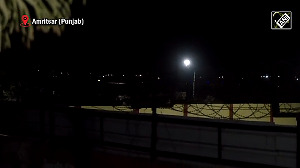The Congress's 3-to-2 score in the five states might appear respectable, but must be seen in perspective. Its Assam win came entirely because of local leaders. The corruption issue hit the Congress in Tamil Nadu and Kerala. And it lost the people's pulse in Puducherry, says Praful Bidwai.
The electorate in five Indian states has delivered a verdict which appears mixed on the surface, but is unambiguous in its central message. That three-fold message is that the people will ruthlessly punish corrupt politicians who sabotage democratic institutions even when they may take some populist welfare measures. People are equally unsparing towards those who profess progressive ideas, but practise the opposite. And they reward those who deliver public services and practise harmony, not divisiveness.
Political parties can ignore this at their own peril. West Bengal and Tamil Nadu witnessed a 'wave' election. They are likely to play a disproportionately large role in the 2014 Lok Sabha elections.
The West Bengal debacle holds a historic lesson for India's parliamentary Left, comprising the Communist Party of India-Marxist, CPI, Forward Bloc and Revolutionary Socialist Party. They cannot practise their conventional politics and hope to survive. They must radically rethink their ideological premises, programmatic perspectives, political mobilisation strategies, and organisational practices. Or, they will go into the dustbin of history.
In Tamil Nadu too, the ruling Dravida Munnetra Kazhagam suffered a crushing, humiliating defeat. Seventeen DMK ministers lost elections. The party was reduced to a pitiable 23 seats, less than the newly-formed, film-star Vijaykanth-led Marumalarchi Dravida Munnetra Kazhagam's 32. The AIADMK-led front gained 12 percentage-points in vote-share and won an 86 percent assembly majority.
In Kerala, the Left Democratic Front lost narrowly to the Congress-led United Democratic Front. The tiny difference of 1.68 lakh in aggregate votes between the two suggests there was no strong anti-incumbency. The LDF staged an impressive rally during the campaign's last stage because of the popular appeal of outgoing chief minister V S Achuthanandan.
The LDF could have won had the CPI-M not hesitated giving a ticket to its sitting chief minister, and then refused to project him as its prospective CM. The result is a slap in the face of CPI-M state secretary Pinarayi Vijayan, who prevailed upon party general secretary Prakash Karat to deny Achutanandan his due.
The Congress doesn't have too much to cheer about. It performed disastrously in Tamil Nadu, winning only five seats in the 234-strong assembly, just half the CPI-M's tally. It bagged 42 seats in West Bengal by piggybacking the Trinamool Congress (184 seats). And it won only 38 of the UDF's 72 seats in Kerala, at a lower strike-rate than its allies'.
It's only in Assam that the Congress did well. Its vote-share improved from 31 percent to 39 and its seats tally from 53 to 78 in the 126-member assembly. This is largely attributable to responsive governance under Chief Minister Tarun Gogoi's two terms, his action against corruption, a considerable improvement in public services, especially healthcare, and his persistent efforts to reconcile differences between ethnic groups and bring secessionist organisations like the United Liberation Front of Asom into the mainstream.
Gogoi's Assam registered an impressive improvement in education and urban services like road maintenance and street-lighting. Over 58 lakh schoolchildren were brought under the purview of mid-day meals. Some 92,000 students were given free computers/laptops on getting high marks in school-leaving examinations. About 1.35 lakh Class 9 and 10 girls were given bicycles. Over 1.5 lakh employees of non-government schools were given Rs 2,000-3,500 in monthly support.
Every Assamese I have recently spoken to testifies to a sea-change in the quality of state healthcare facilities. Rat-infested, ill-equipped, under-staffed and patient-unfriendly dumps that passed off for hospitals became clean, hygienic, efficient and welcoming of patients. Much of the credit for this goes to Health Minister Himanta Biswa Sarma. He was also responsible for the Congress's electoral strategy and candidate selection in many constituencies. All the candidates he chose won.
To return to the elections' most important outcome, the tectonic shift in West Bengal became possible because the Left Front got delusional and failed to notice its growing isolation from the people, especially workers, poor peasants and tenant farmers, caused by its shamelessly elitist, blindly neo-liberal policies.
The front achieved a good deal in its early period in power -- land reform through tenant registration, political decentralisation through what once was India's best panchayati raj system, wage increases, and promotion of communal harmony and a degree of gender equality.
But soon, cadres of the Left, in particular, the CPI-M, 80 percent of whom joined it after it took office, got entrenched in the new power structures and used them to narrow ends. The leadership lost direction and drifted towards conservative policies which neglected the people's basic needs.
West Bengal became a laggard in education, healthcare and job generation. It stands 32nd among 35 states and Union territories in educational achievement. Its school drop-out rate, at 75 percent-plus (all-India average, 60 percent), is the 7th highest in India and higher than in Bihar. The number of hospital beds in rural Bengal is only 3.8 per one lakh people, against a national average of 17.5.
West Bengal has the lowest performance under the National Rural Employment Guarantee Act -- 14 days of work annually against the national average of 42. The share of manufacturing in its state GDP has fallen from 19 percent in the mid-1970s to 7.4 percent -- lower than in neighbouring Orissa (13.6 percent) and way below Gujarat's 30 percent.
On top of this terrible record came the Front's 2006 decision to promote industrialisation-at-any-cost through forcible land acquisition in Singur and Nandigram. These involved sweetheart deals, with the state subsidising 30 percent-plus of the investment.
This brought the Left into an ugly confrontation with its core-base. It fired upon unarmed people but couldn't break their resistance. Singur and Nandigram became symbols of a progressive current gone haywire, become too arrogant to comprehend the people's growing hostility to the Front. Mamata Banerjee understood this and expressed solidarity with people's struggles. She ran an energetic campaign for parivartan (change).
In the ensuing rout, the CPI-M's seat-tally fell below even the Congress's. Twenty six of the front's 34 ministers lost, including Chief Minister Buddhadeb Bhattacharya and his topmost colleagues. The front was wiped out from Kolkata, Howrah, East Midnapur and Darjeeling. In North Bengal, with a high concentration of Muslims, it won only 20 percent of seats, compared to 80 percent in 2006. And in the Adivasi districts of West Midnapur, Purulia and Bankura, where the Left had won 86 percent of seats, it won only about one-third.
This defeat is of the same quality as the Congress's rout in 1977. Karat tried to underplay this by arguing that the Left won 11 lakh more votes than in the 2009 Lok Sabha elections. That's no consolation. This wasn't 'recovery' or 'course correction', but the result of intensive cadre mobilisation.
The Left's leadership now faces its final test. Can it learn from the defeat and bounce back? Some observers have pronounced the death of Communism in India. This is wrong. Communism and Marxism will survive not just as ideologies but even in tangible organisational forms.
The question is if the organised Left parties will retain their importance. They can, only if they relate to life-and-blood people's struggles on livelihood issues and advocate anti-capitalist policies. In West Bengal, these must effectively counter Trinamool's thrust under a right-wing corporate-lobbyist finance minister and Banerjee's unpredictable moves.
The prospect for that other great loser, the DMK, is more dismal. DMK president M Karunanidhi, 87, concentrated all power within his family, destroying what was once a solid cadre-based party and severing it from its moorings in the Dravidian self-respect movement. His relatives built media and industrial empires with his largesse. The 2G scam, and Sun TV and Kalaignar TV are only a few examples of this politics-as-enterprise. After his departure, it's difficult to see how the DMK, bereft of ideology and vision, can survive.
The BJP and Asom Gana Parishad also performed badly in the elections. The AGP was wiped out from 21 of Assam's 27 districts, its seat-tally plummeting from 25 to 10. The BJP was reduced to just five seats. It didn't win even one percent of the 828 seats contested in the five states. This undermines its claim to be emerging as a national party.
The Congress's 3-to-2 score in the five states might appear respectable, but must be seen in perspective. Its Assam win came entirely because of local leaders. The corruption issue hit the Congress in Tamil Nadu and Kerala. And it lost the people's pulse in Puducherry.
Even more important, the results are a slap in the face of the 'Rahul brigade'. Rahul Gandhi had identified Tamil Nadu, with a claimed 1.3 million Youth Congress membership, as a key state. But all nine Youth Congress nominees lost, including the state president and secretary. In Kerala, with almost half-a-million Youth Congress members, only three of Gandhi's 17 handpicked candidates won.
The family 'charisma' isn't working. The Congress must go back to basics if it is to recover in the south, especially in view of the mounting Jaganmohan Reddy challenge in Andhra.








 © 2025
© 2025